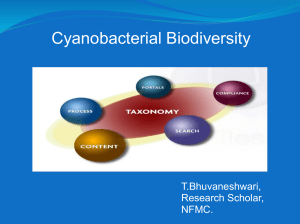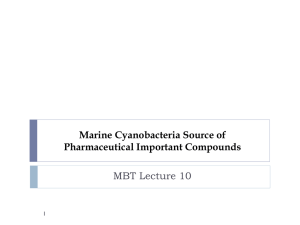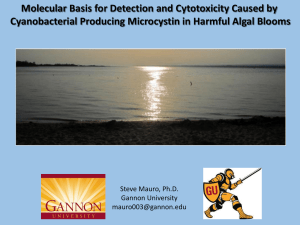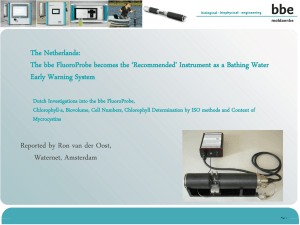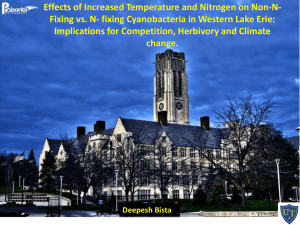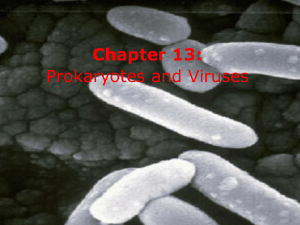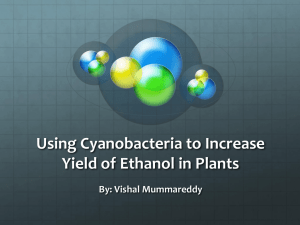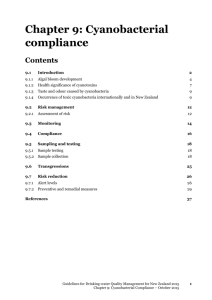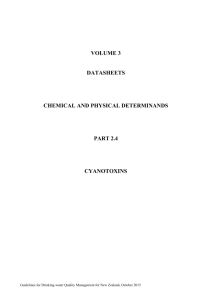CYANOBACTERIAL TOXIN FACTS SHEETS
advertisement
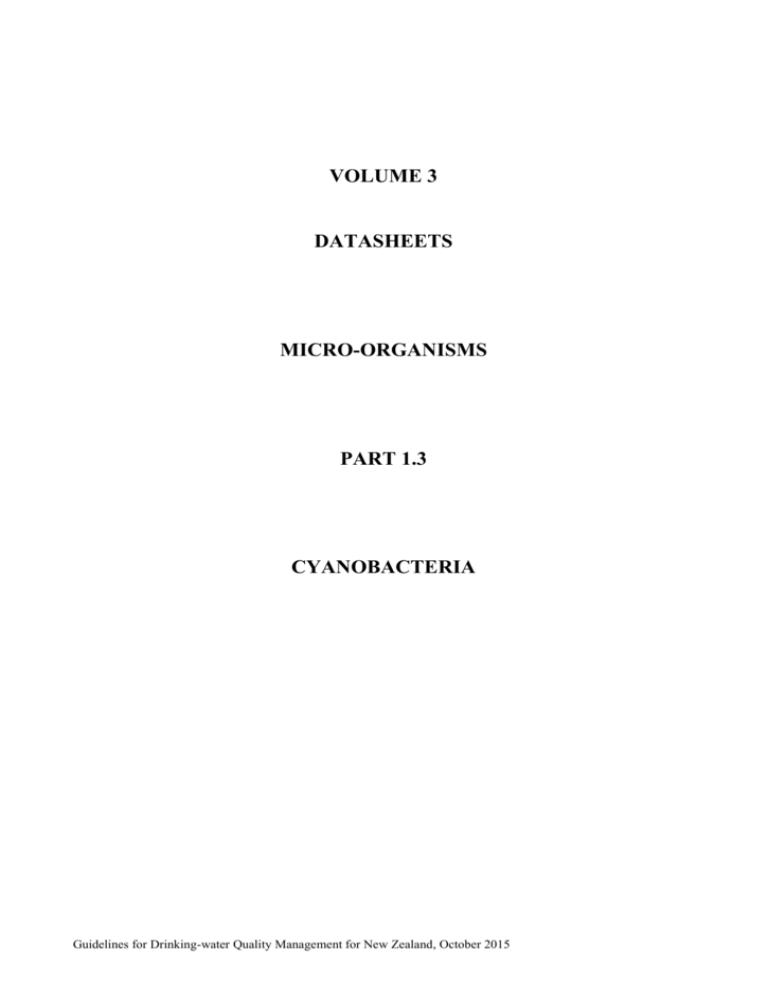
VOLUME 3 DATASHEETS MICRO-ORGANISMS PART 1.3 CYANOBACTERIA Guidelines for Drinking-water Quality Management for New Zealand, October 2015 NOTE: The cyanobacteria are discussed together in this single datasheet. The cyanotoxins are covered individually in Part 2: Datasheets for Chemical and Physical Determinands, 2.4: Cyanotoxins. Guidelines for Drinking-water Quality Management for New Zealand, October 2015 Datasheets Micro-organisms (cyanobacteria) CYANOBACTERIA Maximum Acceptable Value There are no drinking-water MAVs for cyanobacteria in the DWSNZ. MAVs (provisional) have been established for some cyanotoxins. The DWSNZ (2000) had a MAV of less than 1 potentially toxic cyanobacterium present in 10 mL of sample (of drinking-water). There was also a MAV of less than 1 toxic alga present in 10 mL of sample. These MAVs were dropped from DWSNZ 2005 because: cell numbers in drinking-water are difficult to relate to cyanotoxin concentrations counting cells at the 100 per litre level is not very precise cyanotoxin concentrations in drinking-water are more likely to relate to the number of cells in the raw water than in drinking-water cell numbers in the raw water can vary greatly in a short time cell numbers in the source water can vary greatly with horizontal and vertical distribution in water bodies these variations can be quite rapid, depending on wind direction, light and other factors. Background In the past the DWSNZ and Guidelines have referred to toxic algae and blue-green algae. The species used for early nomenclature were blue-green in colour; hence, a common term for these organisms was blue-green algae. However, owing to the production of different pigments, there are a large number that are not blue-green, and they can range in colour from blue-green to yellowbrown to red. They are now called cyanobacteria. It is the cyanotoxins (which are chemicals that they exude) that cause the health effects. Chapter 9 of the Guidelines discusses water supply issues related to managing cyanobacteria and cyanotoxins generally and compliance with the DWSNZ more specifically. Sections 9.5.1 and 9.5.2 of the Guidelines discuss sampling, identifying and counting cyanobacteria, and various Alert Levels. The size of cyanobacterial cells makes a large difference as to how many cyanobacterial cells are likely to represent a public health problem because the cyanotoxin level produced is thought to be approximately proportional to cell volume. It is for this reason the New Zealand Guidelines for Cyanobacteria in Recreational Fresh Waters – Interim Guidelines (2009) recommend biovolume determinations as well as cell counts to estimate the risk to public health from recreational water and this approach is considered to be appropriate for drinking-water sources as well. Health warnings have traditionally been issued when cyanobacterial densities exceed a threshold of 15,000 cells per mL. In recent years cell concentrations of pico-planktonic cyanobacteria (<2 μm) have become increasingly prevalent and at times exceeded this threshold resulting in the unnecessary issuing of health warnings. Biovolume takes into account the variability in size of different species and is therefore a better indicator of potential health risk than cell concentrations. Calculation of biovolume requires time-consuming measurement of individual cells. A list of standardised volumes for cyanobacteria in the Rotorua lakes would greatly assist ENVBOP in incorporating biovolume thresholds into their current monitoring programme. Cawthron Institute and University of Waikato were asked by Environment Bay of Plenty to assemble a list of biovolumes for ten problematic cyanobacteria of the Rotorua lakes. Cell biovolumes were calculated for the following species: Anabaena lemmermannii, A. planktonica, Aphanocapsa Guidelines for Drinking-water Quality Management for New Zealand, October 2015 1 Datasheets Micro-organisms (cyanobacteria) holsatica, Aphanizomenon gracile, Aphanothece clathrata, Coelosphaerium kuetzingianum, Microcystis sp. (small), Microcystis sp. (large), M. wesenbergeii and Snowella lacustris. Wood et al (2008). In Australia there has been an attempt to relate cell numbers to toxin levels. The Australian Drinking-water Guidelines (2011) have suggested a tiered framework involving an initial level to health authorities, and an alert level. Cell concentrations in the raw water relate to toxin concentrations in finished water. The cell concentrations given represent the cell concentrations that are thought to contain sufficient toxin to reach the Australian drinking-water guideline concentration. Notification levels 6,000 cells/mL; biovolume 1.5 mm3/L Cylindrospermopsis raciborskii 4,500 cells/mL; biovolume 0.2 mm3/L Microcystis aeruginosa 2,000 cells/mL; biovolume 0.2 mm3/L Nodularia spumigena 12,000 cells/mL; biovolume 2.7 mm3/L Anabaena circinalis Alert levels 20,000 cells/mL; biovolume 5 mm3/L 15,000 cells/mL; biovolume 0.6 mm3/L 6,500 cells/mL; biovolume 0.6 mm3/L 40,000 cells/mL; biovolume 9.1 mm3/L Since 2001, several more species have been identified as toxic including Anabaena bergii, Raphidiopsis curvata, Oscillatoria formosa and Aphanizomenon flos-aquae for example but these are not included in the Australian Drinking Water Guidelines. In the absence of toxicity data, Australian water suppliers are encouraged to contact relevant health authorities when these organisms are detected. NHMRC, NRMMC (2011) notes that a change of nomenclature has been proposed for Anabaena to Dolichospermum. Sources to Drinking-water The cyanobacteria are a group of photosynthetic bacteria that occur throughout the world. Blooms of cyanobacteria are common in natural surface waters and impoundments. Some species of freshwater cyanobacteria may accumulate on the surface as unsightly blue-green scums. Many species are planktonic (occur suspended in the water column) while others are benthic (attached to surfaces or sediments). Some species of cyanobacteria produce potent toxins, which are broadly classified according to their mode of action as hepatotoxins (microcystins, nodularin and cylindrospermopsin), neurotoxins (saxitoxins, anatoxin-a, anatoxin-a(s) and homoanatoxin-a), skin irritants, broadly termed endotoxins (being skin irritants, these are not covered in the DWSNZ), and other toxins. The cyanotoxins are discussed in more detail in individual datasheets. Cyanobacterial blooms form in water bodies that provide conditions suitable for their growth and which are less favourable for competing algal or plant species. Blooms often occur when adequate levels of essential inorganic nutrients are available, and in water that is slow moving or stagnant. Different temperature ranges suit different species, and some species have the ability to fix atmospheric nitrogen. This gives those species an advantage in waters that are poor in inorganic nitrogen. Blooms can occur at any time of the year, but often occur in late spring, summer or early autumn in the more temperate regions. Optimum growth is controlled by a combination of factors including nutrient availability, light, temperature, water column stability and grazing pressure from zooplankton such as Daphnia sp (e.g. Hietala et al. 1997). Guidelines for Drinking-water Quality Management for New Zealand, October 2015 2 Datasheets Micro-organisms (cyanobacteria) Cyanobacteria growths seem to have been more common in recent years, prompting some people to suggest that this is a result of increasing pollution, or nutrient runoff. This may be incorrect. Cyanobacteria can grow prolifically in “pollution-free” Antarctica, and have been found growing in mountainous regions in New Zealand. If the incidence of cyanobacterial growth is increasing in New Zealand, it could well be due to a reduction of nutrients reaching natural waters. If nitrogenous wastes are diverted from natural waters, thereby causing nitrogen to become a limiting nutrient, cyanobacteria with their nitrogen-fixing ability, would be advantaged. For example, Cylindrospermopsis raciborskii has been found to have a high uptake affinity and storage of phosphorus, dominating in reservoirs and lakes when the phosphate concentrations are below detection limits (Burford and Davis 2011). The buoyancy of some species of cyanobacteria is regulated through the production of carbohydrates during photosynthesis. Photosynthesis causes cells to become denser, so they sink. Respiration uses the carbohydrates and this causes the cells to become less dense and they migrate up to the light, and sometimes to the surface to form the scums. This characteristic allows some cyanobacteria to use nutrients confined to cooler, deeper and often anoxic water, or the light near the surface. Mixing, caused by convection that occurs in reservoirs that are not temperature stratified, or in water bodies that are physically mixed or turbulent like fast flowing rivers, provides conditions less favourable to the growth of cyanobacteria than other algae. Diatoms can often outcompete cyanobacteria in these conditions by providing these otherwise non-motile species with access to both the nutrients and light they need for growth. Heavy rain events can increase nutrient levels in run-off water. This can promote the development of biological growths. Cyanobacteria can respond quickly to changes in conditions, so cyanobacterial blooms may result, if other conditions are right. Heavy rain events also increase sediment levels in the receiving water; some cyanobacteria have been shown to cope with low light conditions, giving them a competitive advantage in dirty water. Toxic and non-toxic strains of the same species can be found together in a bloom (Skulberg et al. 1993, AWWA 1995, Codd and Bell 1996, Orr et al. 2004). Variations in relative concentrations of toxic and non-toxic cells along with differences in the potency of the various toxins they contain means the toxicity of bloom material cannot be determined by microscopic examination. Additionally, changes in toxicity can occur temporally and spatially within a water body (Hrudey et al. 1994) due to movement of cells, changes in species dominance and in rates at which toxins are produced. The unpredictability of toxicity of blooms renders them potentially dangerous and suspect at all times (Ressom et al. 1994). Prevention of cyanobacterial blooms is therefore the key to the control of toxins in source water (WHO 1998). Many environmental factors have been implicated in the production of toxins by cyanobacteria. Orr and Jones (1998) and Long et al. (2001) showed that the rate of microcystin production by nitrogenlimited M. aeruginosa was exactly the same as the rate of cell division. This finding held true for other species of microcystin-producing cyanobacteria including Oscillatoria agardii and Anabaena flos-aquae irrespective of the environmental variable. Hence, for microcystin, a change in toxicity of a bloom is controlled by changes in the biomass of toxic strains within the bloom. Tables 9.1 and 9.2 in the Guidelines show some of the species found internationally and in New Zealand that produce toxins, the nature of the toxin produced, and where the species was found. This list is continually increasing, and should not be regarded as definitive. The tables provide a guide to those trying to determine whether a cyanobacterial species found in a water may be a toxin producer. Toxins are not species-specific, and toxins produced by one species in one location may be produced by a different species elsewhere. Guidelines for Drinking-water Quality Management for New Zealand, October 2015 3 Datasheets Micro-organisms (cyanobacteria) There have been no records of a single cyanobacterial strain producing more than one type of toxin although some strains produce multiple microcystins, and others produce multiple saxitoxins. Individual chemical datasheets are provided for each of the following cyanobacterial toxins: anatoxin-a, anatoxin-a(s), cylindrospermopsin, endotoxins, homoanatoxin-a, microcystins, nodularin, and saxitoxins. Forms and Fate in the Environment Cyanobacterial toxins are either membrane-bound or occur freely within the cells. In laboratory studies, most of the toxin release occurs as cells age and die and passively leak their cellular contents (Orr and Jones 1998), although active release of toxins can occur from young growing cells (Pearson et al. 1990) and from C. raciborskii. Microcystins and anatoxins can be degraded by bacteria (Jones and Orr 1994; Bourne et al. 1996; James et al. 1998) or adsorbed by soils (Morris et al. 2000). Method of Identification and Detection Cyanobacteria are members of the eubacteria group of prokaryotes. They have a typical bacterial intracellular structure except for extensive thylakoid membranes that contain the structure, enzymes and pigments necessary for photosynthesis. They can occur as single cells, as filaments (chains of cells) or colonies. Some species are able to fix atmospheric nitrogen, and some produce gas vacuoles that confer buoyancy enabling those species to migrate vertically in the water column (NHMRC and NRMMC 2004). Although they typically grow aerobically like plants, and fix carbon dioxide in the light during photosynthesis, some can also grow heterotrophically (i.e. using existing organic carbon sources for respiration). This may enable those cyanobacterial species to survive below the euphotic zone and the oxycline (i.e. near the bottom of deep storages in low light and in near-anaerobic conditions). The common problem genera are: Microcystis, Oscillatoria/Planktothrix, Anabaena, Anabaenopsis, Aphanizomenon, Nodularia, Cylindrospermopsis and Phormidium. Definitive identification is often difficult, and considerable variation in morphology can occur within a species. Detailed descriptions are given in Chorus and Bartrum (1999). Some are described in part 10 of APHA (2005). Cyanobacteria are usually identified using high-powered light microscopes, and cells are counted using specialised chambers. The structure of colonies also presents problems in counting. For example, Microcystis can form colonies of a few cells or several thousands of cells that are difficult to separate for counting, and Anabaena forms long tangled filaments. Removal methods Prevention of Bloom Formation Preventing blooms from developing in the first place is the best option for reducing the risk to drinking-water supplies from cyanobacterial toxins. Management strategies such as total catchment management to minimise or control nutrient inflows into water bodies, along with in-reservoir interventions such as destratification to reduce water column stability can minimise nutrient release from sediments and mitigate conditions that promote growth of cyanobacteria (adapted from NHMRC and NRMMC 2004). Benthic cyanobacteria may proliferate in rivers during periods of stable low flows; they may be able to be removed by flushing from an upstream impoundment, if Guidelines for Drinking-water Quality Management for New Zealand, October 2015 4 Datasheets Micro-organisms (cyanobacteria) available. An Australian publication (May 2009) “A Practical Guide to Reservoir Management” Research Report 67 by CRC for Water Quality and Treatment includes cyanobacteria (http://www.waterquality.crc.org.au/publications/report67_Practical_Guide_Reservoir_Management.pdf). One way to prevent blooms is to try to understand what encourages them to grow. McAllister (2014) studied the environmental factors that promoted Phormidium blooms in Canterbury rivers. Sites with regular Phormidium blooms were generally dominated by larger substrate (boulder and cobble). Sites without Phormidium blooms were dominated by smaller substrate (sand/silt, fine gravel and gravel). All sites had low dissolved reactive phosphorus concentrations. There were differences in dissolved inorganic nitrogen concentrations but these did not relate to probability of bloom formation. Phormidium was observed in a range of water temperatures, between 4–20°C. A distinct pattern existed at some sites between flushing flows (3 times median flow) and Phormidium percentage cover, with more frequent flushing flows resulting in decreased Phormidium percentage cover. However, the general flushing rule that three times the median flow is sufficient to remove all Phormidium mats was not applicable in all of the Canterbury rivers studied. A large flushing flow of 22 times the median occurred at Pareora at the huts on the 28.01.2011 and did not remove all the Phormidium. Phormidium had no specific preference for water velocity and depth, but occurred at a range of depths (0.03–0.59 m) and point velocities (0–1.4 ms-1). It appears that water quality is a weak predictor of Phormidium blooms; substrate stability and flow may be the most important factors controlling the dynamics of Phormidium in Canterbury rivers. Use of Algicides Algicides have been used widely in some areas to control cyanobacterial blooms (e.g. KuiperGoodman et al. 1999; Chorus and Mur 1999), sometimes with unforseen negative consequences. Algicides disrupt cells and this can release cell-bound toxins into the surrounding water. The water itself then becomes toxic and can remain so for long periods. Conversely, the toxins released from thick surface scums can be diluted into the rest of the water body and quickly fall to concentrations that are below guideline or detection levels (Jones and Orr 1994). Algicides can also have ecological consequences. They can promote shifts in dominance towards more resistant strains and species. This occurred in California where control, by application using repeated does of copper sulphate (CuSO4), of an Oscillatoria bloom to reduce taste and odour problems, caused a shift to a copper tolerant species of Phormidium. The Phormidium prevailed for longer, and caused year round taste and odour problems (Izaguirre 1992). Copper-based algicide use may also negatively affect populations of environmental microbes that contribute to biodegradation of cyanotoxins in water sources (Smith et al., 2008). Use of CuSO4 can also cause build-up of toxic Cu residues in sediments (Prepas and Murphy, 1988). Use of copper-based algicides is now restricted or banned in many jurisdictions but is still permitted in New Zealand, although rarely used. The application of copper-based algicides is most likely to be effective if used before bloom formation, when cyanobacterial cell numbers and toxin levels are low (Smith et al., 2008). Use of algicides is not recommended as a prima facie method for control of cyanobacteria and should only be considered the option of last resort. If used, algicides must be used strictly in accordance with local environment and chemical registration regulations. They tend to prevent the onset of a bloom rather than dispel a bloom; that implies a certain degree of previous knowledge is needed for its success. Abstraction of Water for Treatment Intake valves in storage reservoirs usually have multiple depths. Deeper levels will invariably have lower cyanobacterial cell concentrations so selective withdrawal of water from a different depth can Guidelines for Drinking-water Quality Management for New Zealand, October 2015 5 Datasheets Micro-organisms (cyanobacteria) minimise the intake of toxic cells to water treatment plants. The level from which to withdraw water will also depend on other water quality criteria because deeper water may be anoxic, and may be high in dissolved Fe and Mn. The cyanotoxins cylindrospermopsin and deoxycylindrospermopsin, which are released from the cyanobacterial cells during cell growth, have been shown to concentrate in sub-surface water layers and this should be considered when determining water abstraction levels when these toxins may be present (Everson et al., 2009). Treatment of Drinking-water This is covered in Chapter 9 of the Guidelines. New Zealand Significance Cyanobacterial blooms have been recorded in New Zealand (e.g. Viner 1987, Carmichael et al. 1988, Rinehart et al. 1988, Hamill 2001) and many of these have tested positive for toxins (Stirling and Quilliam 2001; Wood and Stirling 2003). Occurrence of toxic blooms in New Zealand water bodies continues to increase with blooms being recorded in lakes including the Rotorua Lakes, and constructed reservoirs. They have appeared in the Waikato River. Species recorded in New Zealand that produce toxins appear in Table 9.2 of the Guidelines. Tastes and Odours Cyanobacteria have been recognised as nuisance organisms in the drinking-water and aquaculture industries because some species produce potent odour compounds including geosmin and 2-methyl isoborneol (2-MIB). These compounds (which have datasheets) impart tastes and odours to water and fish flesh. Geosmin is released from cyanobacteria in dry soil when rain first falls and provides that distinctive odour associated with rain. Sensitive individuals can smell geosmin at concentrations approaching 10 ng/L. There is no evidence of any correlation between toxin production and the production of taste and odour compounds. In many cases, different species are responsible (Falconer et al. 1999). Health Considerations Cyanobacteria have been implicated in animal and human poisoning for over 100 years (Francis 1878; Zilberg 1966; Teixera et al. 1993; Negri et al. 1995; Hamill 2001); WHO (1998). The major route of human exposure is the consumption of drinking-water. Other minor exposure routes include accidental ingestion resulting from recreational exposure to contaminated water bodies and ingestion of food or food supplements that might be contaminated by cyanotoxins. An additional, minor route of exposure is through inhalation while taking showers. The WHO allocates 80% of ingestion of cyanotoxins to drinking-water (Falconer et al. 1999). In Australia, the Australian Drinking Water Guidelines (NHMRC and NRMMC 2004) increased this to 90% for some cyanotoxins to reflect differences between Australia and the more generalised conditions defined by the WHO. Microcystins and cylindrospermopsin present the greatest risk to human health because they have both acute and chronic effects, and occur commonly in fresh water systems. Nodularin is of comparable toxicity to the microcystins, but being produced by a saline species, is unlikely to occur in drinking-water. The peptide toxins (microcystins and nodularin) accumulate preferentially in the liver following absorption from the gut. Following acute exposure, they cause a break down in liver ultrastructure Guidelines for Drinking-water Quality Management for New Zealand, October 2015 6 Datasheets Micro-organisms (cyanobacteria) by interfering with enzyme pathways in the liver, and death can occur in as little as 30 minutes from severe liver haemorrhage. Chronic exposure to both the microcystins and nodularin promotes tumour growth while nodularin has been confirmed as a carcinogen in its own right (Ohta et al. 1994). These toxins can also affect other body organs after passing into the bloodstream from the liver. Toxicity data relating to anatoxins is sparse, and completely lacking for human exposure. To date, intoxication by the alkaloid neurotoxins, including the anatoxins and saxitoxins, has only been shown to cause acute effects. Recovery from saxitoxin intoxication is usually complete. Data for saxitoxins is more complete with exposure data being derived from intoxication events resulting from consumption of shellfish contaminated from toxic marine dinoflagellates. Consumption of freshwater shellfish, such as mussels, contaminated by saxitoxins derived from freshwater cyanobacteria is an additional source of ingestion (Negri and Jones 1995). General features of the cyanotoxins – summary: Toxin group1 Primary target organ in Cyanobacterial genus or species (if mammals species specific)2 Cyclic peptides Microcystins Liver Microcystis, Anabaena, Planktothrix/Oscillatora,, Nostoc, Hapalosiphon, Anabaenopsis Nodularin Liver Nodularia spumigena Alkaloids Anatoxin-a Nerve synapse Anabaena, Planktothrix (Oscillatoria), Aphanizomenon, Phormidium Homoanatoxin-a Nerve synapse Phormidium formosa (Oscillatoria formosa) Cylindrospermopsin Liver3 Cylindrospermopsis raciborskii, Aphanizomenon ovalisporum, Umezakia natans Saxitoxins Nerve synapse Anabaena circinalis, Aphanizomenon, Planktothrix, Cylindrospermopsis Lipopolysaccharides (LPS, e.g. endotoxin) Potential irritant; affects any exposed tissue All gram negative bacteria including cyanobacteria, particularly, Lyngbya majuscula 1 Many structural variants may be known for each toxin group. Not produced by all species of the particular genus. Where species name presented, only produced by that species. 3 Whole cells of toxic species elicit widespread tissue damage, including damage to kidney and lymphoid tissue. 2 Guidelines for Drinking-water Quality Management for New Zealand, October 2015 7 Datasheets Micro-organisms (cyanobacteria) Cylindrospermopsin is a hepatotoxic alkaloid found in five species of cyanobacteria. It exhibits an acute response and is thought responsible for an intoxication event in 1979 on Palm Island (North Queensland) where 10 adults and 140 children were admitted to hospital with a range of symptoms including an unusual hepatoenteritis, tender liver enlargement, constipation, vomiting and headache (Falconer 2001). This event became known as Palm Island Mystery Disease and resulted from the deliberate lysing (by CuSO4) of a bloom of what is thought to have been C. raciborskii in Solomon Dam. More recent studies indicate cylindrospermopsin has chronic toxicity as a carcinogen at subacute doses (Humpage and Falconer 2002). An AWQC Research Report (#32, March 2007) updates and summarises the Australian experience. Lipopolysaccharides (LPS) are cell wall components of gram-negative bacteria, the group to which the cyanobacteria belong. Also referred to as endotoxins, LPS can cause both allergic and toxic responses, including skin irritant effects. Little is known currently about the cyanobacterial LPS although they are thought to be less toxic than LPS from other bacteria. The lack of knowledge regarding the occurrence and toxicity of cyanobacterial LPS prevent any guidelines being set. Recent data from Australia has linked exposure to blooms of the cyanobacteria Lyngbya majuscula to skin irritant effects (Osborne et al., 2008; Osborne and Shaw, 2008). In order to set safe levels of toxicants or contaminants in food or drinking-water (called the Maximum Acceptable Value or MAV), it is first necessary to determine the dose level in humans that poses the maximum acceptable risk when taken over a lifetime. Studies involving animals (usually pigs, rats and mice) provide basic epidemiological data to determine either the Lowest Observable Adverse Effect Level (LOAEL) where some doubt exists about the exact maximum dose that causes no adverse effect, or the No Observable Adverse Effect Level (NOAEL) where the maximum dose that causes no adverse effect has been determined accurately. This is then converted to the average permissible daily intake based on a lifetime of exposure. After application of appropriate safety factors, this value is called the Tolerable Daily Intake (TDI), or sometimes the Acceptable Daily Intake (ADI). Acute exposure Acute exposure is a single (or brief) exposure that results in an immediate adverse health effect. The recorded cases of gastrointestinal and hepatic illness that can be attributed reliably to cyanobacterial toxins in water supplies have all been coincident with either the breakdown of a natural cyanobacterial bloom, or with the artificial lysis of a bloom by application of algicides. In the USA and Australia, several different cyanobacterial toxins have been implicated in human illness from municipal water supplies, often after algal blooms had been treated with copper sulphate (Bourke et al. 1983; Falconer 1989, Ressom et al. 1994). In most cases, the cyanobacteria and sometimes the toxins involved have been identified, but the levels of toxin associated with illness have not been established in any of the outbreaks. The most lethal outbreak attributed to cyanobacterial toxins in drinking water occurred in Brazil, when a newly flooded dam developed a bloom of toxic M. aeruginosa. Approximately 2,000 gastroenteritis cases, 88 of which resulted in death were reported over a 42-day period (Teixera et al.1993). Also in Brazil, 117 of 136 patients (86 per cent) experienced visual disturbances, nausea, vomiting, muscle weakness and painful hepatomegaly, following routine treatment at a haemodialysis centre. Subsequently, 100 patients developed acute liver failure and 50 of these died. Note that NHMRC, NRMMC (2011) states: No human deaths have been recorded from ingesting the toxins of cyanobacteria but gastroenteritis may result from drinking water containing toxic species and extended Guidelines for Drinking-water Quality Management for New Zealand, October 2015 8 Datasheets Micro-organisms (cyanobacteria) exposure may lead to more serious impacts. Deaths have been attributed to the presence of microcystin in water used for renal dialysis in Caruara, Brazil (Jochimsen et al 1998). Chronic exposure Chronic exposure is one or more exposures to sub-acute doses that result in an adverse health effect over the lifetime of an individual. Only the hepatotoxins have been demonstrated unequivocally to have chronic health effects at subacute doses. ANZECC/ARMCANZ (2000) gives guideline values for livestock drinking water, and includes the following: “Algal blooms should be treated as possibly toxic and the water source should be withdrawn from stock until the algae are identified and the level of toxin determined. An increasing risk to livestock health is likely when cell counts of Microcystis exceed 11,500 cells/mL and/or concentrations of microcystins exceed 2.3 μg/L expressed as microcystin-LR toxicity equivalents. There are insufficient data available to derive trigger values for other species of cyanobacteria”. These guidelines were meant to have been updated in 2012. Bibliography ANZECC/ARMCANZ (2000). Australian and New Zealand Guidelines for Fresh and Marine Water Quality. http://www.mfe.govt.nz/publications/water/anzecc-water-quality-guide02/anzecc-water-quality-guide-02-pdfs.html or or http://www.daff.gov.au/oldmincos/publications/australian_and_new_zealand_guidelines_for _fresh_and_marine_water_quality APHA (2005). Standard Methods for the Examination of Water and Wastewater (21st Edition). Washington: American Public Health Association, American Water Works Association, Water Environment Federation. AWQC (2007). Regulation of Cylindrospermopsin Production by the Cyanobacterium Cylindrospermopsis raciborskii. Research Report #32. 40 pp. www.waterquality.crc.org.au AWWA (1995). Cyanobacterial (blue-green algal) toxins: a resource guide. Denver, CO, AWWA Research Foundation and American Water Works Association. Bourke, A. T. C. et al. (1983). An outbreak of hepato-enteritis (the Palm Island mystery disease) possibly caused by algal intoxication. In: Toxicon (Suppl. 3) pp 45-48. Bourne, D. G., G. J. Jones, R. L. Blakeley, A. Jones, A. P. Negri and P. Riddles (1996). Enzymatic pathway for the bacterial degradation of the cyanobacterial cyclic peptide toxin microcystin LR. Appl. Environ. Microbiol., 62, pp 4086-4094. Burford, MA and TW Davis (2011). Physical and chemical processes promoting dominance of the toxic cyanobacterium Cylindrospermopsis raciborskii. 21 pp. http://www98.griffith.edu.au/dspace/bitstream/handle/10072/43510/76606_1.pdf?sequence=1 Carmichael, W. W., J. T. Eschedor, G. M. L. Patterson and R. E. Moore (1988). Toxicity and partial structure of a hepatotoxic peptide produced by the cyanobacterium Nodularia spumigena Mertens emend. L575 from New Zealand. Applied and Environmental Microbiology, 54, pp 2257-2263. Chorus and Bartrum (Eds) (1999). Toxic cyanobacteria in water. A guide to their public health consequences, monitoring and management. Published on behalf of the World Health Organisation by E & FN Spon. ISBN 0-419-23930-8. The book is included in the plan of work of the rolling revision of the WHO Guidelines for Drinking-water Quality. http://www.who.int/water_sanitation_health/resourcesquality/toxicyanbact/en/index.html Chorus, I. and L. Mur. In: Chorus, I. and J. Bartrum (Editors) (1999). Toxic cyanobacteria in water. A guide to their public health consequences, monitoring and management. 416 pp. Guidelines for Drinking-water Quality Management for New Zealand, October 2015 9 Datasheets Micro-organisms (cyanobacteria) Published on behalf of the World Health Organisation by E&FN Spon, London. http://www.who.int/water_sanitation_health/resourcesquality/toxicyanbact/en/index.html Codd, G. A. and S. G. Bell (1996). The occurrence and fate of blue-green algal toxins in freshwaters. Her Majesty’s Stationary Office, London. (National Rivers Authority R and D Report 29). Everson, S., L. Fabbro, S. Kinnear, G. Eaglesham and P. Wright (2009). Distribution of the cyanobacterial toxins cylindrospermopsin and deoxycylindrospermopsin in a stratified lake in north-eastern New South Wales, Australia. Marine and Freshwater Research, 60, pp 2533. Falconer, I. R. (1989). Effects on human health of some toxic cyanobacteria (blue-green algae) in reservoirs, lakes and rivers. Toxicity Assessment, 4, pp 175-184. Falconer, I. R. (2001). Toxic cyanobacteria bloom problems in Australian waters: risks and impacts on human health. Phycologia, 40, pp 228-233. Falconer, I., J. Bartrum, I. Chorus, T. Kuiper-Goodman, H. Utkilen, M. Burch and G. A. Codd (1999). Safe Levels and Safe Practices. In: Chorus, I. and J. Bartrum (Editors). Toxic cyanobacteria in water. A guide to their public health consequences, monitoring and management. 416 pp. Published on behalf of the World Health Organisation by E&FN Spon, London. http://www.who.int/water_sanitation_health/resourcesquality/toxicyanbact/en/index.html Francis, G. (1878). Poisonous Australian Lake. Nature, 18, pp 11-12. Hamill, K. (2001). Toxicity in benthic freshwater cyanobacteria (blue-green algae): first observations in New Zealand. New Zealand Journal of Marine and Freshwater Research, 35, pp 1057-1059. Hietala, J., C. Laurén-Määttä and M. Walls (1997). Life history responses of Daphnia clones to toxic Microcystis at different food levels. Journal of Plankton Research, 19, pp 917-926. Hrudey, S. E., T. W. Lambert and S. L. Kenefick (1994). Health risk assessment of microcystins in drinking water supplies. In: Toxic cyanobacteria – a global perspective, pp 7-12. Adelaide, Australian Centre for Water Quality Research. Humpage, A. and I. Falconer (2002). Oral toxicity to Swiss albino mice of the cyanobacterial toxin cylindrospermopsin administered daily over 11 weeks. Canadian Research Centre for Water Quality and Treatment, Research Report No. 13. Izaguirre, G. (1992). A copper-tolerant Phormidium species from Lake Mathiews, California, that produces 2-methylisoborneol and geosmin. Water Sci. Tech., 25, pp 217-223. James, K. J., A. Furey, I. R. Sherlock, M. A. Stack, M. Twohig, F. B. Caudwell and O. M. Skulberg (1998). Sensitive determination of anatoxin-a, homoanantoxin-a and their degradation products by liquid chromatography with fluorimetric detection. J. Chromatogr., 798, pp 147-157. Jones, G. J. and P. T. Orr (1994). Release and degradation of microcystin following algicide treatment of a Microcystis aeruginosa bloom in a recreational lake, as determined by HPLC and protein phosphatase inhibition assay. Water Res., 28, pp 871-876. Jochimsen EM, Carmichael WW, An JS, Cardo DM, Cookson ST, Holmes CE, Antunes MB, Filho DA, Lyra TM, Barreto VS (1998). Liver failure and death after exposure to microcystins at a hemodialysis center in Brazil. New England Journal of Medicine, 338, pp 873-878. Kuiper-Goodman, T., I. Falconer and J. Fitzgerald (1999). Safe Levels and Safe Practices. In: Chorus, I. and J. Bartrum (Editors): Toxic Cyanobacteria in Water. A Guide to their Public Health Consequences, Monitoring and Management. 416 pp. Published on behalf of the World Health Organisation by E&FN Spon, London. http://www.who.int/water_sanitation_health/resourcesquality/toxicyanbact/en/index.html Long, B. M., G. J. Jones and P. T. Orr (2001). Cellular microcystin content in N-limited Microcystis aeruginosa can be predicted from growth rate. Appl. Environ. Microbiol., 67, pp 278–28. Guidelines for Drinking-water Quality Management for New Zealand, October 2015 10 Datasheets Micro-organisms (cyanobacteria) McAllister, T. (2014). Environmental factors that promote Phormidium blooms in Canterbury rivers. Waterways Centre for Freshwater Management Report WCFM 2014-001. 44 pp. http://waterways.ac.nz/documents/Technical%20reports/WCFM%20TR%202014001%20Environmental%20factors%20that%20promote%20phormidium%20blooms.pdf Ministry for the Environment and Ministry of Health (2009). New Zealand Guidelines for Cyanobacteria in Recreational Fresh Waters – Interim Guidelines. Prepared for the Ministry for the Environment and the Ministry of Health by SA Wood, DP Hamilton, WJ Paul, KA Safi and WM Williamson. Wellington: Ministry for the Environment. See http://www.mfe.govt.nz/publications/water/guidelines-for-cyanobacteria/index.html Morris, R. J., D. E. Williams, H. A. Luu, C. E. Holmes, R. A. Andersen and S. E. Calvert (2000). The adsorption of microcystin-LR by natural clay particles. Toxicon, 38, pp 303-308. NHMRC and NRMMC (2004). Australian Drinking Water Guidelines. Published by the National Health and Medical Research Council and the Natural Resource Management Ministerial Council, Canberra. See: http://www.nhmrc.gov.au/publications/synopses/eh19syn.htm or see latest edition: NHMRC, NRMMC (2011). Australian Drinking Water Guidelines Paper 6. National Water Quality Management Strategy. National Health and Medical Research Council, National Resource Management Ministerial Council, Commonwealth of Australia, Canberra. See Fact Sheet and Chapter 5. http://www.nhmrc.gov.au/_files_nhmrc/publications/attachments/eh52_aust_drinking_water _guidelines_update_120710_0.pdf Negri, A. P., G. J. Jones and M. Hindmarsh (1995). Sheep mortality associated with paralytic shellfish poisons from the cyanobacterium Anabaena circinalis. Toxicon, 33, pp 13211329. Negri, A. P. and G. J. Jones (1995). Bioaccumulation of paralytic shellfish poisoning toxins from the cyanobacterium Anabaena circinalis by the freshwater mussel Alathyria condola. Toxicon, 33, pp 667-678. Newcombe G., House J., Ho L., Baker P. and Burch M. (2009). Management Strategies for Cyanobacteria (Blue‐Green Algae) and their Toxins: A Guide for Water Utilities. WQRA research report 74. 112 pp. http://www.wqra.com.au/WQRA_publications.htm Ohta, T., E. Sueoka, N. Iida, A. Komori, M. Suganuma, R. Nishikawa, M. Tatematsu, S. J. Kim, W. W. Carmichael and H. Fujiki (1994). Nodularin, a potent inhibitor of protein phosphatases 1 and 2A, is a new environmental carcinogen in male F344 rat liver. Cancer Research, 54, pp 6402-6406. Orr, P. T. and G. J. Jones (1998). Relationship between microcystin production and cell division rates in nitrogen-limited Microcystis aeruginosa cultures. Limnol. Oceangr., 43, pp 16041614. Orr, P. T., G. J. Jones, and G. Douglas (2004). Response of cultured Microcystis aeruginosa from the Swan River, Australia, to elevated salt concentration and consequences for bloom and toxin management in estuaries. Marine and Freshwater Research, 55, pp 277-283. Osborne, N., and G. Shaw (2008). Dermatitis associated with exposure to a marine cyanobacterium during recreational water exposure. BMC Dermatology, 8, p 5. Osborne, N., A. Seawright and G. Shaw (2008). Dermal toxicology of Lyngbya majuscula from Moreton Bay, Queensland, Australia. Harmful Algae, 7, pp 584-589. Prepas, E. E. and T. P. Murphy (1988). Sediment-water interactions in farm dugouts previously treated with copper sulfate. NODLN., 4, pp 161-168. Pearson, M. J., A. D. J. Ferguson, G. A. Codd, C. S. Reynolds, J. K. Fawell, R. M. Hamilton, S. R. Howard and M. R. Attwood (1990). Toxic blue-green algae. The report to the National Rivers Authority. Water Quality Series No.2, NRA Peterborough, UK. Ressom, R., F. Soong, J. Fitzgerald, L. Turczynowcz, O. El Saadi, D. Roder, T. Maynard and I. Falconer (1994). Health effects of toxic cyanobacteria (blue green algae). National Health and Medical Research Council, Canberra. Guidelines for Drinking-water Quality Management for New Zealand, October 2015 11 Datasheets Micro-organisms (cyanobacteria) Rinehart, K. L., K. Harada, M. Namikoshi, C. Chen and C. A. Harvis (1988). Nodularin, microcystin, and the configuration of adda. J Am. Chem. Soc., 110, pp 8557-8558. Sivonen, K. and G. Jones (1999). Cyanobacterial Toxins. In: Chorus, I. and J. Bartrum (Editors). Toxic Cyanobacteria in Water. A Guide to their Public Health Consequences, Monitoring and Management. 416 pp. Published on behalf of the World Health Organisation by E&FN Spon, London. Skulberg, O. M., W. W. Carmichael, G. Codd and R. Skulberg (1993). Taxonomy of toxic Cyanophyceae (cyanobacteria). In: Falconer, I. R., editor. Algal Toxins in Seafood and Drinking Water. London, Academic Press, pp 146-164. Smith, M. J., G. R. Shaw, G. K. Eaglesham, L. Ho and J. D. Brookes (2008). Elucidating the factors influencing the biodegradation of cylindrospermopsin in drinking water sources. Environmental Toxicology, 23, pp 413-421. Stirling, D. J. and M. A. Quilliam (2001). First report of the cyanobacterial toxin cylindrospermopsin in New Zealand. Toxicon, 39, pp 1219-1222. Teixera, M. G. L. C., M. C. N. Costa, V. L. P. Carvalho, M. S. Pereira and E. Hage (1993). Gastroenteritis epidemic in the area of the Itaparica Dam, Bahia, Brazil. Bulletin of the Pan American Health Organisation, 27, pp 244-253. Viner, A. B. (1987). Cyanobacteria in New Zealand inland waters: Experimental studies. N.Z. J. Mar. Freshwater Res., 21, pp 503-507. WHO (1998). Guidelines for Drinking-water Quality, 2nd ed. addendum to vol 2. Health Criteria and other Supporting Information. Geneva, World Health Organisation. pp 95-110. WHO (2004). Guidelines for Drinking-water Quality (3rd Ed.). Geneva: World Health Organization. Available at: http://www.who.int/water_sanitation_health/dwq/gdwq3rev/en/ see also the addenda WHO (2011). Guidelines for Drinking-water Quality 2011 (4th Ed.). Geneva: World Health Organization. Available at: http://www.who.int/water_sanitation_health/publications/2011/dwq_guidelines/en/index.html WQRA (2009). International Guidance Manual for the Management of Toxic Cyanobacteria. Edited by Dr Gayle Newcombe, Australian Water Quality Centre, a business unit of SA Water Corporation. Copyright: Global Water Research Coalition (UK). http://www.wqra.com.au/cyanobacteriamanual/PDF/GWRCGuidanceManualManagementToxicCyanobacteria.pdf Wood, S. A. and D. J. Stirling (2003). First identification of the cylindrospermopsin-producing cyanobacterium Cylindrospermopsis raciborskii in New Zealand. New Zealand Journal of Marine and Freshwater Research, 37, pp 821-828. Wood, S.A., J. P. Rasmussen, P. T. Holland, R. Campbell and A. L. M. Crowe (2007). First report of the cyanotoxin anatoxin-A from Aphanizomenon issatschenkoi (cyanobacteria). Journal of Phycology, 43, pp 356-365. Wood, SA, Paul, WJ, Hamilton DP (2008). Cyanobacterial Biovolumes for the Rotorua Lakes. Prepared for Environment BoP. Cawthron Report No. 1504. 19 pp. http://www.boprc.govt.nz/media/32233/Cawthron-090803CyanobacterialbiovolumesforRotorualakes.pdf Zilberg, B. (1966). Gastroenteritis in Salisbury European children – a five year study. Central African Journal of Medicine, 12, pp 164-168. Guidelines for Drinking-water Quality Management for New Zealand, October 2015 12
